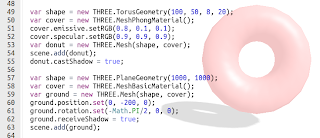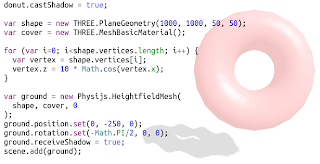According to my little tag cloud, I have written 48 posts on Physijs. In all those posts and all the research necessary for them, I somehow managed to never come across the
HeightField class in the list of supported objects. Thankfully Chandler Prall made mention of them, so now I at least know of their existence. I have absolutely no idea if they will be of any use to me in 3D Game Programming for Kids. There is no way to know unless I take at least a little time to play.Before I get started, it is worth noting that there is a nifty sample page for HeightField on the physijs site.
I have a simple lights an materials chapter in the book that takes the reader though creating a donut and shadow (and eventually animation):
var shape = new THREE.TorusGeometry(100, 50, 8, 20);
var cover = new THREE.MeshPhongMaterial();
cover.emissive.setRGB(0.8, 0.1, 0.1);
cover.specular.setRGB(0.9, 0.9, 0.9);
var donut = new THREE.Mesh(shape, cover);
scene.add(donut);
donut.castShadow = true;
var shape = new THREE.PlaneGeometry(1000, 1000);
var cover = new THREE.MeshBasicMaterial();
var ground = new THREE.Mesh(shape, cover);
ground.position.set(0, -200, 0);
ground.rotation.set(-Math.PI/2, 0, 0);
ground.receiveShadow = true;
scene.add(ground);
To get started with
HeightField, I replace the ground that is created from a THREE.Mesh to a Physijs.HieghtField: var shape = new THREE.PlaneGeometry(1000, 1000);
var cover = new THREE.MeshBasicMaterial();
var ground = new Physijs.HeightfieldMesh(
shape, cover, 0
);
// ...To get height in my height field, I need to change the z value of the vertices in the ground. To achieve smooth bumps in the height field, I divide up the geometry shape into a 50 by 50 grid. Then I work through each vertex in the resultant shape, setting the z value to the cosine of the x position:
for (var i=0; i<shape.vertices.length; i++) {
var vertex = shape.vertices[i];
vertex.z = 10 * Math.cos(vertex.x);
}
So, of course I make that into rolling hills and add controls to the donut to speed about:

Good times.
These height field objects are definitely pretty cool. I am still not sure if I have a good use for them in the book, but I will let the idea percolate for a while. Hopefully I can come up with something...
Day #690
No comments:
Post a Comment